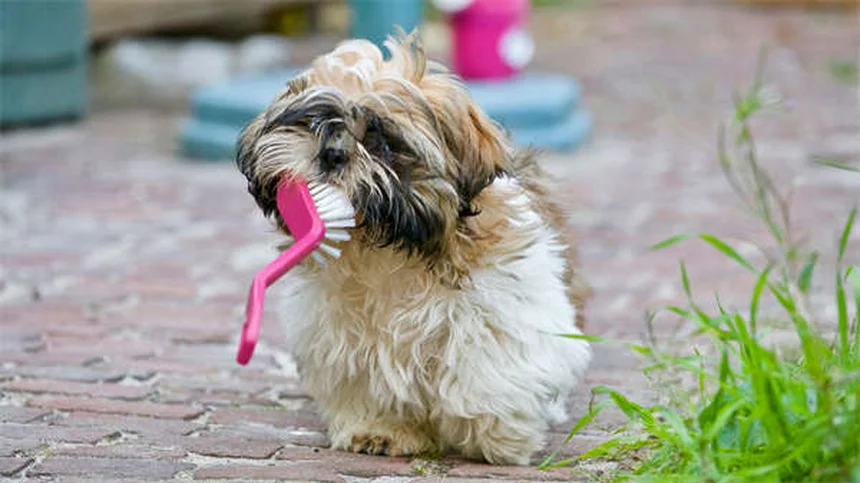Why is my cat vomiting or having diarrhea? The answer is: your feline friend likely has one of these 7 common cat GI problems we see every day in veterinary practice. From pesky parasites to serious conditions like IBD, cat tummy troubles come in many forms - but the good news is most are treatable when caught early. I've been treating cats with digestive issues for over a decade, and let me tell you, early intervention makes all the difference. In this guide, we'll walk through each issue so you can spot the warning signs and know exactly when to call your vet. Trust me, your cat's gut will thank you!
E.g. :5 Sneaky Spots Where Ticks Hide on Cats (And How to Remove Them Safely)
- 1、When Your Cat's Tummy Goes Rogue: Common GI Issues Explained
- 2、When Things Get Backed Up: Constipation Woes
- 3、The Things Cats Swallow: Foreign Body Adventures
- 4、IBD: When the Gut Gets Angry
- 5、Food Allergies: More Than Just Picky Eating
- 6、Cancer: The Tough Diagnosis
- 7、When to See the Vet
- 8、The Hidden Dangers of Hairballs You Never Considered
- 9、The Water Crisis: Why Your Cat Isn't Drinking Enough
- 10、The Poop Detective: What Your Cat's Stool Reveals
- 11、The Silent Epidemic: Obesity and Digestive Health
- 12、The Supplement Craze: What Actually Helps
- 13、FAQs
When Your Cat's Tummy Goes Rogue: Common GI Issues Explained
Those Pesky Intestinal Party Crashers
Ever wonder why your cat's been acting off lately? Intestinal parasites might be throwing an unwanted party in their gut. These uninvited guests include roundworms, tapeworms, hookworms, whipworms, and coccidia - basically the worst houseguests imaginable.
Here's the deal: these critters don't just mooch off your cat's nutrients, they cause real problems like vomiting, diarrhea, and weight loss. I've seen kittens so full of worms they looked like they swallowed a spaghetti factory! The good news? Treatment is straightforward once your vet identifies the culprit through a fecal exam.
| Medication | Target Parasites | Form |
|---|---|---|
| Profender® | Hookworms, roundworms, tapeworms | Topical liquid |
| Drontal® | Hookworms, roundworms, tapeworms | Tablet |
The Hairball Chronicles
Let's talk about everyone's favorite gross topic - hairballs. While occasional hairballs happen, frequent ones signal trouble. Is your cat grooming excessively due to skin issues? Or is their digestive system not moving hair through properly?
For mild cases, try these home remedies:• Hairball control food• Special gels to lubricate the gut• Increased fiber• More frequent brushing
Did you know some cats develop hairballs the size of golf balls? That's when you know it's time to call the vet! Regular grooming can prevent most hairball issues - think of it as spa day for your feline friend.
When Things Get Backed Up: Constipation Woes
 Photos provided by pixabay
Photos provided by pixabay
Recognizing the Signs
If your cat's spending more time in the litter box than usual with little to show for it, constipation might be the culprit. You'll notice small, hard stools - imagine trying to pass little rocks. Not fun for anyone!
Common causes include:• Dehydration• Poor gut motility• Pain or neurological issues• Megacolon (an enlarged colon)
Treatment and Prevention
Never attempt home enemas - some types can be toxic to cats! Your vet might need to manually remove impacted stool under sedation. For chronic cases, we focus on prevention:
• Increase water intake (try a cat fountain)• Dietary adjustments (fiber changes work wonders)• Weight management (chubby cats are more prone)• More exercise (laser pointers to the rescue!)
The Things Cats Swallow: Foreign Body Adventures
Why Cats Eat Weird Stuff
Cats explore the world with their mouths, which explains why I've removed everything from hair ties to LEGO pieces from feline stomachs. Small objects might pass through, but larger ones get stuck, causing vomiting and pain.
Did you know string is especially dangerous? It can "accordion" the intestines, causing severe damage. Always keep sewing supplies and rubber bands out of reach!
 Photos provided by pixabay
Photos provided by pixabay
Recognizing the Signs
Vets use X-rays to spot foreign objects, though sometimes we only see indirect signs. Endoscopy can remove some objects, but others require surgery. Prevention is key - cat-proof your home like you would for a toddler with superpowers.
IBD: When the Gut Gets Angry
Understanding Inflammatory Bowel Disease
IBD causes chronic vomiting, diarrhea, and weight loss. It's tricky to diagnose because we need intestinal biopsies. Symptoms often start mild but worsen over time - like a slow-burning fire in the digestive tract.
Potential triggers include:• Food allergies• Bacterial imbalances• Stress• Genetic factors
Managing IBD
Treatment starts with hypoallergenic diets. If that's not enough, we might use medications to calm the overactive immune response. Many cats do well with proper management - it's about finding what works for your individual cat.
Food Allergies: More Than Just Picky Eating
 Photos provided by pixabay
Photos provided by pixabay
Recognizing the Signs
Beef, fish, and chicken top the list of feline food allergies. Less common offenders include dairy, wheat, and eggs. Symptoms range from itchy skin to chronic diarrhea - basically your cat's way of saying "this food doesn't agree with me!"
The Elimination Diet Challenge
Diagnosing food allergies requires an 8-12 week elimination diet using special hypoallergenic food. No treats, no table scraps - just the prescribed diet. It's tough but worth it to identify the problem ingredients.
Some cats also need medications to control inflammation while we figure out their dietary triggers. Patience is key - this process can't be rushed!
Cancer: The Tough Diagnosis
Lymphoma and Other GI Cancers
Lymphoma is the most common GI cancer in cats. Symptoms mimic other digestive issues, which makes diagnosis challenging. Modern treatments like chemotherapy can extend good quality life - many cats tolerate it better than humans do!
Treatment Options
Depending on the cancer type and stage, options include:• Surgery• Chemotherapy• Radiation• Palliative care
The goal is maintaining quality of life. With proper treatment, many cats enjoy months to years of happy living after diagnosis.
When to See the Vet
Red Flags to Watch For
Persistent vomiting or diarrhea lasting more than 24 hours warrants a vet visit. Other warning signs include:• Blood in stool or vomit• Lethargy• Loss of appetite• Unexplained weight loss
Prevention Tips
Regular vet checkups catch problems early. Keep vaccinations current, maintain parasite prevention, and feed high-quality food appropriate for your cat's age and health status. A little prevention goes a long way in keeping your cat's digestive system running smoothly!
Remember, you know your cat best. If something seems off, trust your instincts and consult your veterinarian. Early intervention makes all the difference in managing GI issues effectively.
The Hidden Dangers of Hairballs You Never Considered
When Hairballs Become More Than Just Gross
You think hairballs are just an annoying byproduct of cat ownership? Think again! Severe hairball blockages can actually become life-threatening if left untreated. That innocent-looking furball could be silently causing inflammation in your cat's intestines right now.
Here's something most cat owners don't realize - hairballs don't always come up. Sometimes they travel the wrong way through the digestive system, creating dangerous obstructions. I once treated a Persian cat whose intestines were completely blocked by a hairball the size of a tennis ball! The surgery took hours, but thankfully Mr. Whiskers made a full recovery.
The Surprising Connection Between Stress and Hairballs
Did you know your cat's stress levels directly impact their hairball production? Anxious cats groom excessively, swallowing way more hair than necessary. Changes in your routine, new pets in the house, or even rearranged furniture can trigger this behavior.
Here's a quick stress test for your cat: Are they grooming certain spots bald? Do they hide more than usual? These signs, combined with increased hairballs, suggest your feline needs some zen in their life. Try pheromone diffusers, quiet spaces, and predictable routines to help them chill out.
The Water Crisis: Why Your Cat Isn't Drinking Enough
Understanding Your Cat's Thirst Instincts
Cats evolved from desert animals, so their thirst drive is practically nonexistent. This biological quirk explains why your cat might ignore their water bowl while slowly dehydrating. Wild cats got most moisture from prey, but dry kibble offers almost none.
Here's a shocking fact: Many cats live in a constant state of mild dehydration without showing obvious symptoms. Their urine becomes concentrated, their skin loses elasticity, and their organs work harder. Not exactly the picture of health, right?
Creative Hydration Solutions That Actually Work
Forget just putting out a water bowl - that's like expecting a teenager to voluntarily eat vegetables. You need to get creative:
| Method | Effectiveness | Cat Appeal |
|---|---|---|
| Running water fountain | High | Most cats love moving water |
| Wet food diet | Very High | Depends on pickiness |
| Ice cubes in water | Moderate | Some cats enjoy playing with them |
My personal favorite trick? Add a splash of tuna water or chicken broth (low sodium!) to their water. It's like cat crack - they can't resist it. Just change it frequently to prevent bacterial growth.
The Poop Detective: What Your Cat's Stool Reveals
Decoding the Color Spectrum
Ever examined your cat's poop like it's some kind of furry Rorschach test? You should! Color changes can signal serious health issues long before other symptoms appear. Here's your quick guide:
• Black/tarry: Possible internal bleeding (call vet immediately)• Red streaks: Lower GI bleeding or parasites• Green: Could indicate gallbladder issues• White specks: Likely tapeworm segments (eww)
Remember that time your cat had weirdly pale stools after eating that blue toy mouse? Yeah, that's why we keep small objects away from curious kitties!
Consistency Clues You're Probably Missing
Perfect cat poop should be firm but not hard, formed but not dry. Think Play-Doh consistency (sorry for the visual). Anything significantly different warrants attention.
Here's a pro tip: Use the Bristol Stool Chart adapted for cats. If their poop consistently falls in types 1-2 (hard lumps or sausage-shaped but lumpy), they're probably constipated. Types 6-7 (mushy or liquid) suggest diarrhea. Aim for that sweet spot in the middle!
The Silent Epidemic: Obesity and Digestive Health
Why Fat Cats Have More GI Problems
You might think your chonky kitty is adorable, but that extra weight is wreaking havoc on their digestive system. Obese cats have slower gut motility, making them prone to constipation, hairballs, and even diabetes.
Here's something that might surprise you - just 2 extra pounds on a cat is equivalent to 30-40 pounds on an average human! Imagine carrying around a heavy backpack all day, every day. No wonder their digestion suffers.
Portion Control Tricks That Actually Work
Putting your cat on a diet isn't as simple as giving less food. Cats are master manipulators - they'll have you convinced they're starving within hours. Here's how to outsmart them:
• Use puzzle feeders to slow down eating• Divide meals into smaller, more frequent portions• Switch to higher-protein, lower-carb foods• Hide food in different locations to encourage movement
My favorite success story? A 20-pound tabby named Meatball who lost 5 pounds through a combination of food puzzles and laser pointer chases. His chronic constipation cleared up completely once he reached a healthy weight!
The Supplement Craze: What Actually Helps
Probiotics - Miracle Cure or Hype?
Walk into any pet store and you'll see shelves of probiotic supplements promising to fix your cat's digestion. But do they actually work? The answer is... sometimes.
Quality matters tremendously with probiotics. Many products contain strains that don't survive stomach acid or aren't feline-specific. Look for veterinary-recommended brands with guaranteed live cultures and proper storage requirements. When in doubt, ask your vet!
Fiber Supplements - Not One Size Fits All
Adding fiber can help some cats with constipation or diarrhea, but it's not a universal solution. Too much insoluble fiber can actually worsen certain conditions like IBD.
Here's a quick comparison of common fiber sources:
• Psyllium husk: Great for constipation but can cause gas• Canned pumpkin: Gentle option for mild cases• Methylcellulose: Often prescribed for chronic constipation• Wheat bran: Too harsh for most cats
Remember that time you added too much pumpkin to your cat's food and they turned the litter box into a pumpkin spice latte disaster? Yeah, moderation is key with fiber supplements!
E.g. :Cat Digestive Problems: Symptoms, Diagnosis, and Treatment ...
FAQs
Q: How can I tell if my cat has intestinal parasites?
A: Watch for these telltale signs of parasites in cats: vomiting, diarrhea, weight loss despite eating well, or a pot-bellied appearance (especially in kittens). Some worms like tapeworms may show up as rice-like segments near your cat's rear end. The only way to know for sure? Get a fecal test done at your vet's office. We examine the stool under a microscope to identify specific parasites - it's way more accurate than guessing. Treatment depends on the parasite type, but most respond well to dewormers like Profender or Drontal. Remember, even indoor cats can get parasites, so regular fecal checks are a must!
Q: Are hairballs normal for cats?
A: Here's the scoop on hairballs: while occasional ones (like once a month) might be normal, frequent hairballs signal something's off. Healthy cats should pass most hair through their stool. If your cat's hacking up hairballs weekly, it could mean excessive grooming from skin issues or slow gut motility. Try these fixes: brush your cat daily (seriously, it helps!), use a hairball control diet, or try a vet-approved hairball gel. If problems persist after 2-3 weeks of home care, see your vet - we've got stronger remedies to get things moving properly.
Q: What's the best way to prevent constipation in cats?
A: As a vet, I recommend these proven constipation prevention tips: First, increase water intake - try a cat fountain since many felines prefer running water. Second, feed wet food (the moisture helps!). Third, add fiber gradually - pumpkin puree (not pie filling!) works wonders. Fourth, keep your cat active with daily play sessions. And most importantly, maintain a healthy weight - overweight cats are more prone to constipation. If your cat hasn't pooped in 48 hours or seems uncomfortable, don't wait - call your vet immediately as severe cases can become life-threatening.
Q: My cat ate something weird - when should I worry?
A: Foreign body emergencies are more common than you'd think! If you saw your cat swallow something unusual, call your vet right away - don't wait for symptoms. Dangerous items include strings, hair ties, small toys, or anything sharp. Warning signs include vomiting, not eating, or acting painful. Here's my rule of thumb: if it's longer than 2 inches or made of materials that won't digest (like plastic or metal), it probably needs removal. Some objects can cause intestinal perforation within hours, so when in doubt, get it checked out. Pro tip: cat-proof your home like you would for a toddler!
Q: How is IBD diagnosed and treated in cats?
A: Diagnosing feline IBD requires intestinal biopsies, usually taken via endoscopy or surgery. First we rule out other causes with bloodwork, fecal tests, and ultrasound. Treatment starts with a strict hypoallergenic diet trial (no cheating!) for 8-12 weeks. If diet alone doesn't help, we may add medications like steroids to reduce inflammation. The good news? With proper management, many IBD cats live happy, normal lives. I recommend keeping a symptom diary to track what works best for your individual cat. Remember - IBD is a marathon, not a sprint, so patience with treatment adjustments is key.


